Police Custody and Ethical Dilemmas
VerifiedAdded on 2020/05/28
|16
|3969
|116
AI Summary
This assignment delves into the complex ethical challenges faced within the context of police custody. It examines issues related to the treatment of detainees with mental health conditions, safeguarding vulnerable individuals, and the application of restorative justice principles. Students are expected to analyze relevant legislation, policies, and academic literature to critically evaluate best practices and potential areas for improvement in ensuring ethical and humane treatment during police custody.
Contribute Materials
Your contribution can guide someone’s learning journey. Share your
documents today.
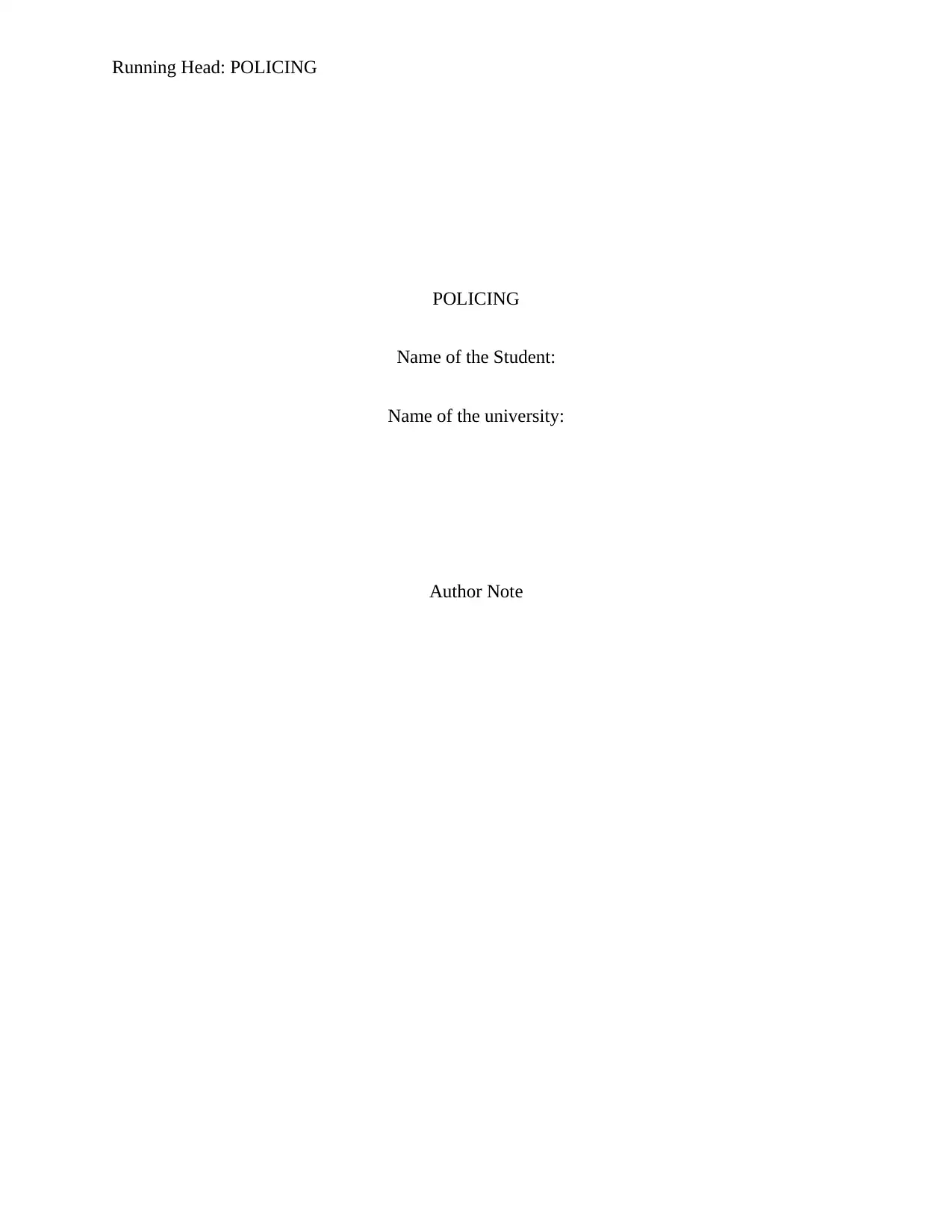
Running Head: POLICING
POLICING
Name of the Student:
Name of the university:
Author Note
POLICING
Name of the Student:
Name of the university:
Author Note
Secure Best Marks with AI Grader
Need help grading? Try our AI Grader for instant feedback on your assignments.
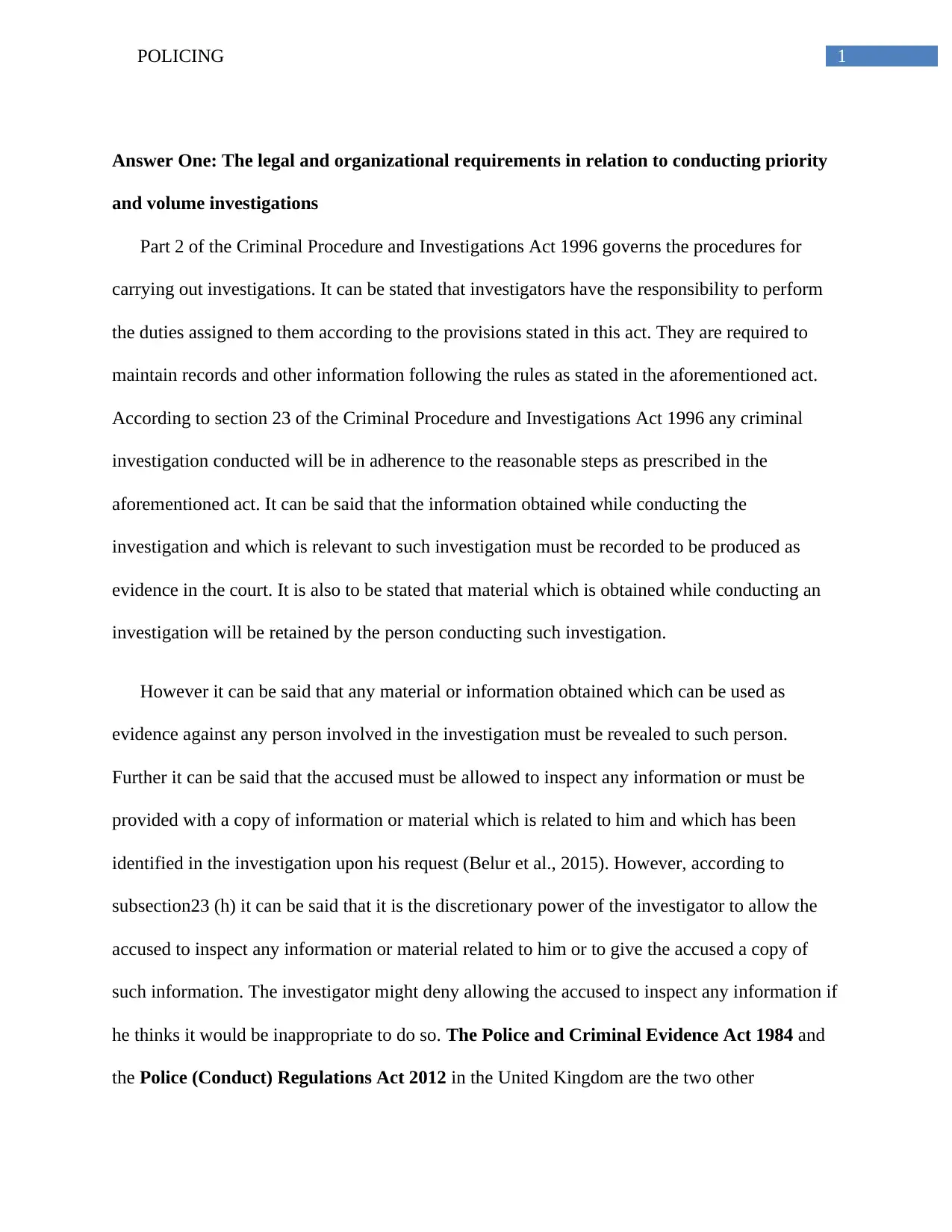
1POLICING
Answer One: The legal and organizational requirements in relation to conducting priority
and volume investigations
Part 2 of the Criminal Procedure and Investigations Act 1996 governs the procedures for
carrying out investigations. It can be stated that investigators have the responsibility to perform
the duties assigned to them according to the provisions stated in this act. They are required to
maintain records and other information following the rules as stated in the aforementioned act.
According to section 23 of the Criminal Procedure and Investigations Act 1996 any criminal
investigation conducted will be in adherence to the reasonable steps as prescribed in the
aforementioned act. It can be said that the information obtained while conducting the
investigation and which is relevant to such investigation must be recorded to be produced as
evidence in the court. It is also to be stated that material which is obtained while conducting an
investigation will be retained by the person conducting such investigation.
However it can be said that any material or information obtained which can be used as
evidence against any person involved in the investigation must be revealed to such person.
Further it can be said that the accused must be allowed to inspect any information or must be
provided with a copy of information or material which is related to him and which has been
identified in the investigation upon his request (Belur et al., 2015). However, according to
subsection23 (h) it can be said that it is the discretionary power of the investigator to allow the
accused to inspect any information or material related to him or to give the accused a copy of
such information. The investigator might deny allowing the accused to inspect any information if
he thinks it would be inappropriate to do so. The Police and Criminal Evidence Act 1984 and
the Police (Conduct) Regulations Act 2012 in the United Kingdom are the two other
Answer One: The legal and organizational requirements in relation to conducting priority
and volume investigations
Part 2 of the Criminal Procedure and Investigations Act 1996 governs the procedures for
carrying out investigations. It can be stated that investigators have the responsibility to perform
the duties assigned to them according to the provisions stated in this act. They are required to
maintain records and other information following the rules as stated in the aforementioned act.
According to section 23 of the Criminal Procedure and Investigations Act 1996 any criminal
investigation conducted will be in adherence to the reasonable steps as prescribed in the
aforementioned act. It can be said that the information obtained while conducting the
investigation and which is relevant to such investigation must be recorded to be produced as
evidence in the court. It is also to be stated that material which is obtained while conducting an
investigation will be retained by the person conducting such investigation.
However it can be said that any material or information obtained which can be used as
evidence against any person involved in the investigation must be revealed to such person.
Further it can be said that the accused must be allowed to inspect any information or must be
provided with a copy of information or material which is related to him and which has been
identified in the investigation upon his request (Belur et al., 2015). However, according to
subsection23 (h) it can be said that it is the discretionary power of the investigator to allow the
accused to inspect any information or material related to him or to give the accused a copy of
such information. The investigator might deny allowing the accused to inspect any information if
he thinks it would be inappropriate to do so. The Police and Criminal Evidence Act 1984 and
the Police (Conduct) Regulations Act 2012 in the United Kingdom are the two other
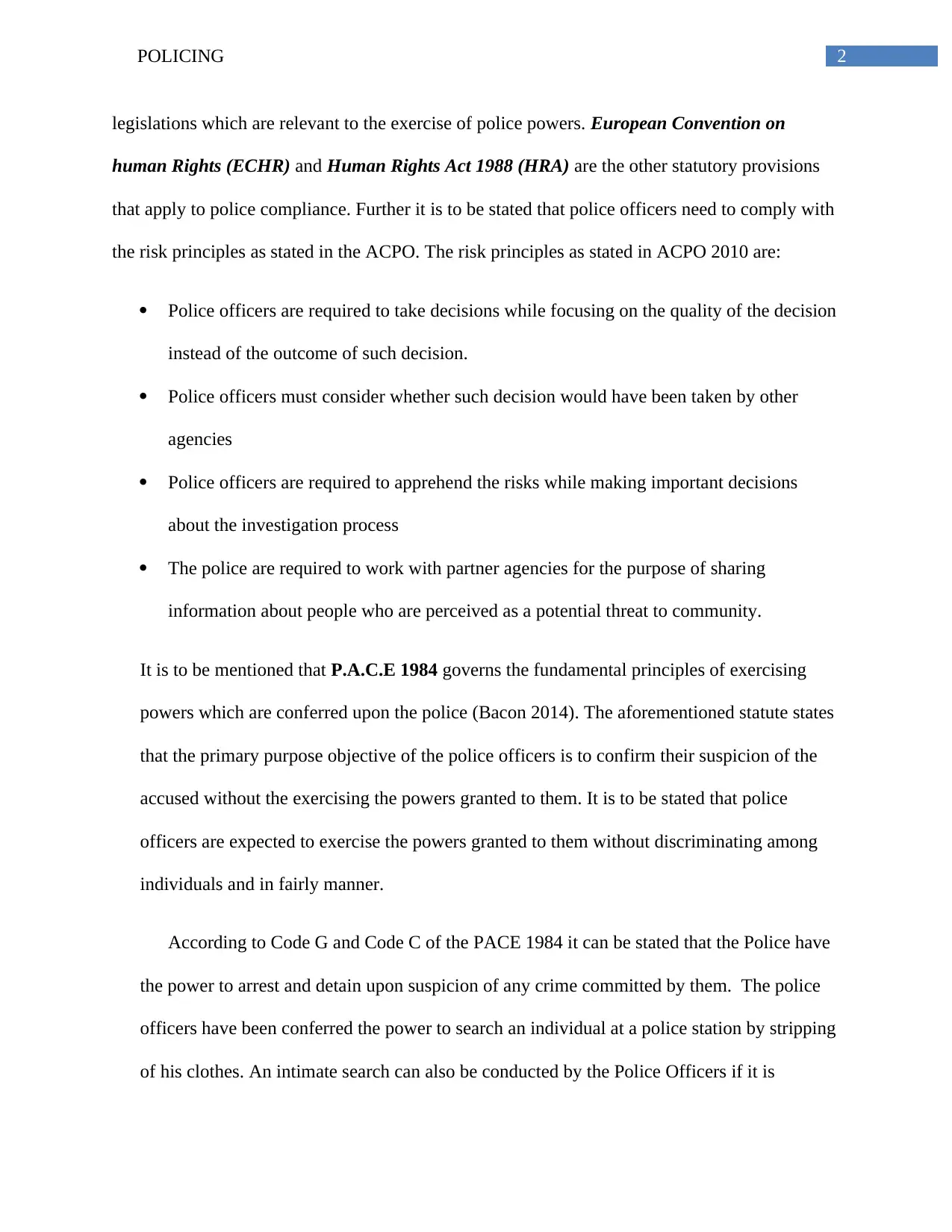
2POLICING
legislations which are relevant to the exercise of police powers. European Convention on
human Rights (ECHR) and Human Rights Act 1988 (HRA) are the other statutory provisions
that apply to police compliance. Further it is to be stated that police officers need to comply with
the risk principles as stated in the ACPO. The risk principles as stated in ACPO 2010 are:
Police officers are required to take decisions while focusing on the quality of the decision
instead of the outcome of such decision.
Police officers must consider whether such decision would have been taken by other
agencies
Police officers are required to apprehend the risks while making important decisions
about the investigation process
The police are required to work with partner agencies for the purpose of sharing
information about people who are perceived as a potential threat to community.
It is to be mentioned that P.A.C.E 1984 governs the fundamental principles of exercising
powers which are conferred upon the police (Bacon 2014). The aforementioned statute states
that the primary purpose objective of the police officers is to confirm their suspicion of the
accused without the exercising the powers granted to them. It is to be stated that police
officers are expected to exercise the powers granted to them without discriminating among
individuals and in fairly manner.
According to Code G and Code C of the PACE 1984 it can be stated that the Police have
the power to arrest and detain upon suspicion of any crime committed by them. The police
officers have been conferred the power to search an individual at a police station by stripping
of his clothes. An intimate search can also be conducted by the Police Officers if it is
legislations which are relevant to the exercise of police powers. European Convention on
human Rights (ECHR) and Human Rights Act 1988 (HRA) are the other statutory provisions
that apply to police compliance. Further it is to be stated that police officers need to comply with
the risk principles as stated in the ACPO. The risk principles as stated in ACPO 2010 are:
Police officers are required to take decisions while focusing on the quality of the decision
instead of the outcome of such decision.
Police officers must consider whether such decision would have been taken by other
agencies
Police officers are required to apprehend the risks while making important decisions
about the investigation process
The police are required to work with partner agencies for the purpose of sharing
information about people who are perceived as a potential threat to community.
It is to be mentioned that P.A.C.E 1984 governs the fundamental principles of exercising
powers which are conferred upon the police (Bacon 2014). The aforementioned statute states
that the primary purpose objective of the police officers is to confirm their suspicion of the
accused without the exercising the powers granted to them. It is to be stated that police
officers are expected to exercise the powers granted to them without discriminating among
individuals and in fairly manner.
According to Code G and Code C of the PACE 1984 it can be stated that the Police have
the power to arrest and detain upon suspicion of any crime committed by them. The police
officers have been conferred the power to search an individual at a police station by stripping
of his clothes. An intimate search can also be conducted by the Police Officers if it is
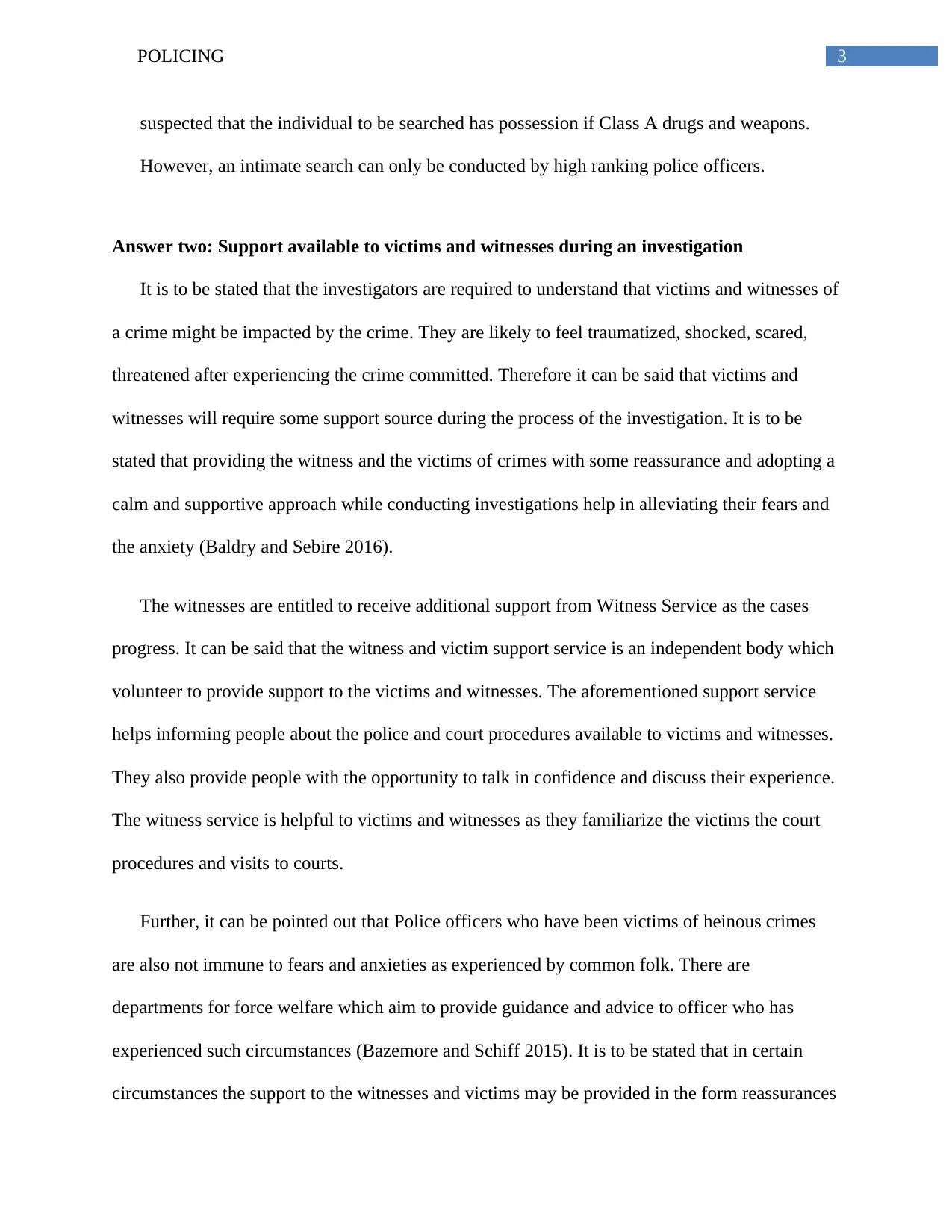
3POLICING
suspected that the individual to be searched has possession if Class A drugs and weapons.
However, an intimate search can only be conducted by high ranking police officers.
Answer two: Support available to victims and witnesses during an investigation
It is to be stated that the investigators are required to understand that victims and witnesses of
a crime might be impacted by the crime. They are likely to feel traumatized, shocked, scared,
threatened after experiencing the crime committed. Therefore it can be said that victims and
witnesses will require some support source during the process of the investigation. It is to be
stated that providing the witness and the victims of crimes with some reassurance and adopting a
calm and supportive approach while conducting investigations help in alleviating their fears and
the anxiety (Baldry and Sebire 2016).
The witnesses are entitled to receive additional support from Witness Service as the cases
progress. It can be said that the witness and victim support service is an independent body which
volunteer to provide support to the victims and witnesses. The aforementioned support service
helps informing people about the police and court procedures available to victims and witnesses.
They also provide people with the opportunity to talk in confidence and discuss their experience.
The witness service is helpful to victims and witnesses as they familiarize the victims the court
procedures and visits to courts.
Further, it can be pointed out that Police officers who have been victims of heinous crimes
are also not immune to fears and anxieties as experienced by common folk. There are
departments for force welfare which aim to provide guidance and advice to officer who has
experienced such circumstances (Bazemore and Schiff 2015). It is to be stated that in certain
circumstances the support to the witnesses and victims may be provided in the form reassurances
suspected that the individual to be searched has possession if Class A drugs and weapons.
However, an intimate search can only be conducted by high ranking police officers.
Answer two: Support available to victims and witnesses during an investigation
It is to be stated that the investigators are required to understand that victims and witnesses of
a crime might be impacted by the crime. They are likely to feel traumatized, shocked, scared,
threatened after experiencing the crime committed. Therefore it can be said that victims and
witnesses will require some support source during the process of the investigation. It is to be
stated that providing the witness and the victims of crimes with some reassurance and adopting a
calm and supportive approach while conducting investigations help in alleviating their fears and
the anxiety (Baldry and Sebire 2016).
The witnesses are entitled to receive additional support from Witness Service as the cases
progress. It can be said that the witness and victim support service is an independent body which
volunteer to provide support to the victims and witnesses. The aforementioned support service
helps informing people about the police and court procedures available to victims and witnesses.
They also provide people with the opportunity to talk in confidence and discuss their experience.
The witness service is helpful to victims and witnesses as they familiarize the victims the court
procedures and visits to courts.
Further, it can be pointed out that Police officers who have been victims of heinous crimes
are also not immune to fears and anxieties as experienced by common folk. There are
departments for force welfare which aim to provide guidance and advice to officer who has
experienced such circumstances (Bazemore and Schiff 2015). It is to be stated that in certain
circumstances the support to the witnesses and victims may be provided in the form reassurances
Secure Best Marks with AI Grader
Need help grading? Try our AI Grader for instant feedback on your assignments.
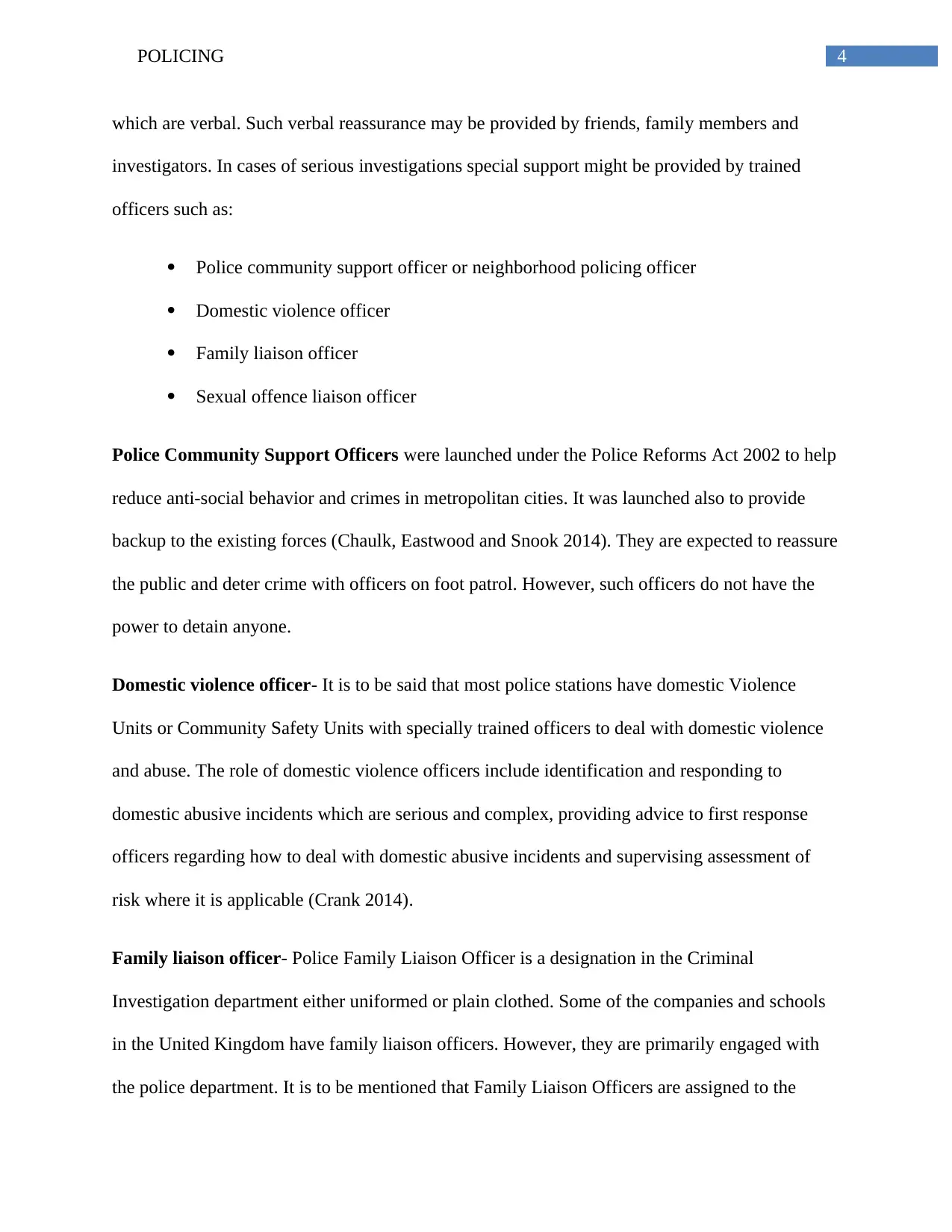
4POLICING
which are verbal. Such verbal reassurance may be provided by friends, family members and
investigators. In cases of serious investigations special support might be provided by trained
officers such as:
Police community support officer or neighborhood policing officer
Domestic violence officer
Family liaison officer
Sexual offence liaison officer
Police Community Support Officers were launched under the Police Reforms Act 2002 to help
reduce anti-social behavior and crimes in metropolitan cities. It was launched also to provide
backup to the existing forces (Chaulk, Eastwood and Snook 2014). They are expected to reassure
the public and deter crime with officers on foot patrol. However, such officers do not have the
power to detain anyone.
Domestic violence officer- It is to be said that most police stations have domestic Violence
Units or Community Safety Units with specially trained officers to deal with domestic violence
and abuse. The role of domestic violence officers include identification and responding to
domestic abusive incidents which are serious and complex, providing advice to first response
officers regarding how to deal with domestic abusive incidents and supervising assessment of
risk where it is applicable (Crank 2014).
Family liaison officer- Police Family Liaison Officer is a designation in the Criminal
Investigation department either uniformed or plain clothed. Some of the companies and schools
in the United Kingdom have family liaison officers. However, they are primarily engaged with
the police department. It is to be mentioned that Family Liaison Officers are assigned to the
which are verbal. Such verbal reassurance may be provided by friends, family members and
investigators. In cases of serious investigations special support might be provided by trained
officers such as:
Police community support officer or neighborhood policing officer
Domestic violence officer
Family liaison officer
Sexual offence liaison officer
Police Community Support Officers were launched under the Police Reforms Act 2002 to help
reduce anti-social behavior and crimes in metropolitan cities. It was launched also to provide
backup to the existing forces (Chaulk, Eastwood and Snook 2014). They are expected to reassure
the public and deter crime with officers on foot patrol. However, such officers do not have the
power to detain anyone.
Domestic violence officer- It is to be said that most police stations have domestic Violence
Units or Community Safety Units with specially trained officers to deal with domestic violence
and abuse. The role of domestic violence officers include identification and responding to
domestic abusive incidents which are serious and complex, providing advice to first response
officers regarding how to deal with domestic abusive incidents and supervising assessment of
risk where it is applicable (Crank 2014).
Family liaison officer- Police Family Liaison Officer is a designation in the Criminal
Investigation department either uniformed or plain clothed. Some of the companies and schools
in the United Kingdom have family liaison officers. However, they are primarily engaged with
the police department. It is to be mentioned that Family Liaison Officers are assigned to the
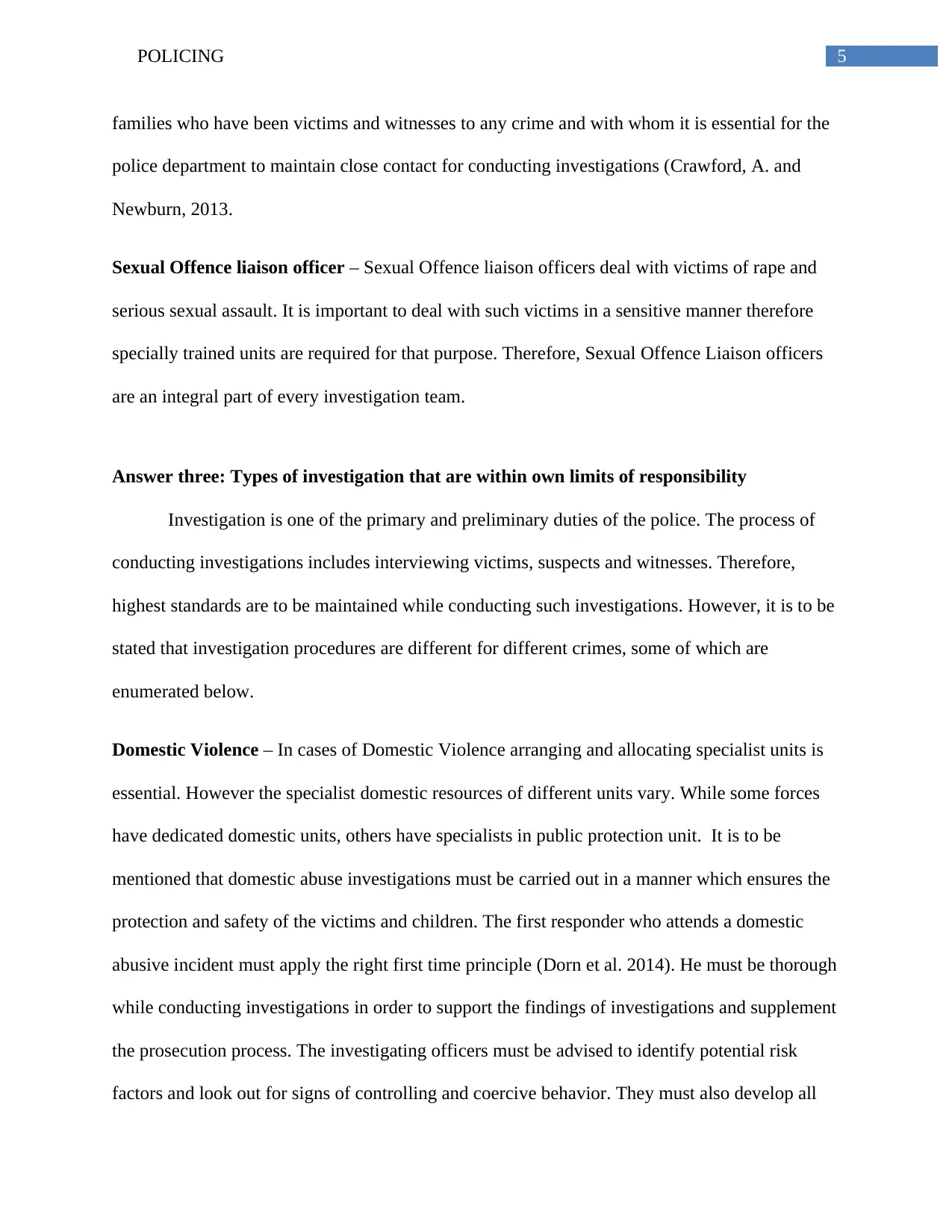
5POLICING
families who have been victims and witnesses to any crime and with whom it is essential for the
police department to maintain close contact for conducting investigations (Crawford, A. and
Newburn, 2013.
Sexual Offence liaison officer – Sexual Offence liaison officers deal with victims of rape and
serious sexual assault. It is important to deal with such victims in a sensitive manner therefore
specially trained units are required for that purpose. Therefore, Sexual Offence Liaison officers
are an integral part of every investigation team.
Answer three: Types of investigation that are within own limits of responsibility
Investigation is one of the primary and preliminary duties of the police. The process of
conducting investigations includes interviewing victims, suspects and witnesses. Therefore,
highest standards are to be maintained while conducting such investigations. However, it is to be
stated that investigation procedures are different for different crimes, some of which are
enumerated below.
Domestic Violence – In cases of Domestic Violence arranging and allocating specialist units is
essential. However the specialist domestic resources of different units vary. While some forces
have dedicated domestic units, others have specialists in public protection unit. It is to be
mentioned that domestic abuse investigations must be carried out in a manner which ensures the
protection and safety of the victims and children. The first responder who attends a domestic
abusive incident must apply the right first time principle (Dorn et al. 2014). He must be thorough
while conducting investigations in order to support the findings of investigations and supplement
the prosecution process. The investigating officers must be advised to identify potential risk
factors and look out for signs of controlling and coercive behavior. They must also develop all
families who have been victims and witnesses to any crime and with whom it is essential for the
police department to maintain close contact for conducting investigations (Crawford, A. and
Newburn, 2013.
Sexual Offence liaison officer – Sexual Offence liaison officers deal with victims of rape and
serious sexual assault. It is important to deal with such victims in a sensitive manner therefore
specially trained units are required for that purpose. Therefore, Sexual Offence Liaison officers
are an integral part of every investigation team.
Answer three: Types of investigation that are within own limits of responsibility
Investigation is one of the primary and preliminary duties of the police. The process of
conducting investigations includes interviewing victims, suspects and witnesses. Therefore,
highest standards are to be maintained while conducting such investigations. However, it is to be
stated that investigation procedures are different for different crimes, some of which are
enumerated below.
Domestic Violence – In cases of Domestic Violence arranging and allocating specialist units is
essential. However the specialist domestic resources of different units vary. While some forces
have dedicated domestic units, others have specialists in public protection unit. It is to be
mentioned that domestic abuse investigations must be carried out in a manner which ensures the
protection and safety of the victims and children. The first responder who attends a domestic
abusive incident must apply the right first time principle (Dorn et al. 2014). He must be thorough
while conducting investigations in order to support the findings of investigations and supplement
the prosecution process. The investigating officers must be advised to identify potential risk
factors and look out for signs of controlling and coercive behavior. They must also develop all
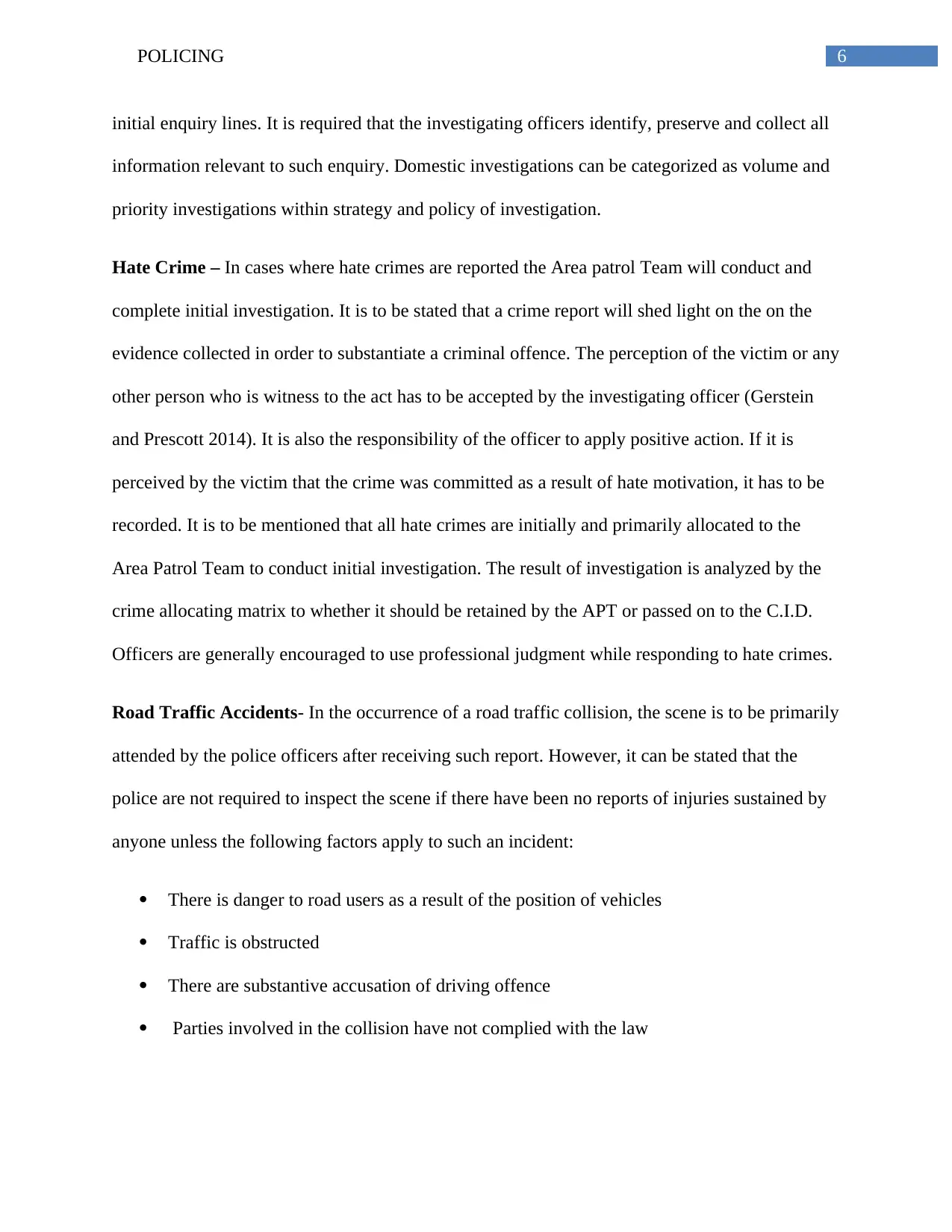
6POLICING
initial enquiry lines. It is required that the investigating officers identify, preserve and collect all
information relevant to such enquiry. Domestic investigations can be categorized as volume and
priority investigations within strategy and policy of investigation.
Hate Crime – In cases where hate crimes are reported the Area patrol Team will conduct and
complete initial investigation. It is to be stated that a crime report will shed light on the on the
evidence collected in order to substantiate a criminal offence. The perception of the victim or any
other person who is witness to the act has to be accepted by the investigating officer (Gerstein
and Prescott 2014). It is also the responsibility of the officer to apply positive action. If it is
perceived by the victim that the crime was committed as a result of hate motivation, it has to be
recorded. It is to be mentioned that all hate crimes are initially and primarily allocated to the
Area Patrol Team to conduct initial investigation. The result of investigation is analyzed by the
crime allocating matrix to whether it should be retained by the APT or passed on to the C.I.D.
Officers are generally encouraged to use professional judgment while responding to hate crimes.
Road Traffic Accidents- In the occurrence of a road traffic collision, the scene is to be primarily
attended by the police officers after receiving such report. However, it can be stated that the
police are not required to inspect the scene if there have been no reports of injuries sustained by
anyone unless the following factors apply to such an incident:
There is danger to road users as a result of the position of vehicles
Traffic is obstructed
There are substantive accusation of driving offence
Parties involved in the collision have not complied with the law
initial enquiry lines. It is required that the investigating officers identify, preserve and collect all
information relevant to such enquiry. Domestic investigations can be categorized as volume and
priority investigations within strategy and policy of investigation.
Hate Crime – In cases where hate crimes are reported the Area patrol Team will conduct and
complete initial investigation. It is to be stated that a crime report will shed light on the on the
evidence collected in order to substantiate a criminal offence. The perception of the victim or any
other person who is witness to the act has to be accepted by the investigating officer (Gerstein
and Prescott 2014). It is also the responsibility of the officer to apply positive action. If it is
perceived by the victim that the crime was committed as a result of hate motivation, it has to be
recorded. It is to be mentioned that all hate crimes are initially and primarily allocated to the
Area Patrol Team to conduct initial investigation. The result of investigation is analyzed by the
crime allocating matrix to whether it should be retained by the APT or passed on to the C.I.D.
Officers are generally encouraged to use professional judgment while responding to hate crimes.
Road Traffic Accidents- In the occurrence of a road traffic collision, the scene is to be primarily
attended by the police officers after receiving such report. However, it can be stated that the
police are not required to inspect the scene if there have been no reports of injuries sustained by
anyone unless the following factors apply to such an incident:
There is danger to road users as a result of the position of vehicles
Traffic is obstructed
There are substantive accusation of driving offence
Parties involved in the collision have not complied with the law
Paraphrase This Document
Need a fresh take? Get an instant paraphrase of this document with our AI Paraphraser
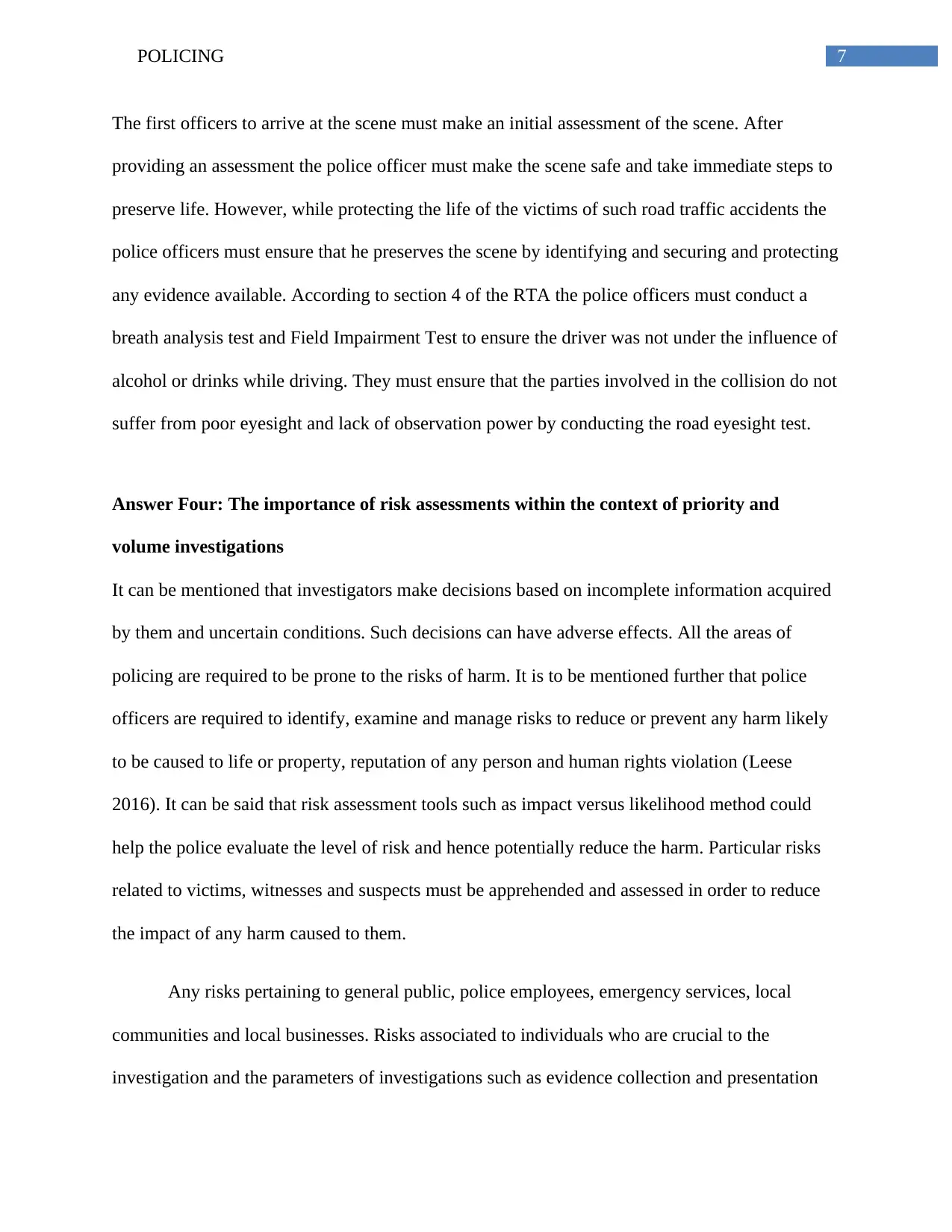
7POLICING
The first officers to arrive at the scene must make an initial assessment of the scene. After
providing an assessment the police officer must make the scene safe and take immediate steps to
preserve life. However, while protecting the life of the victims of such road traffic accidents the
police officers must ensure that he preserves the scene by identifying and securing and protecting
any evidence available. According to section 4 of the RTA the police officers must conduct a
breath analysis test and Field Impairment Test to ensure the driver was not under the influence of
alcohol or drinks while driving. They must ensure that the parties involved in the collision do not
suffer from poor eyesight and lack of observation power by conducting the road eyesight test.
Answer Four: The importance of risk assessments within the context of priority and
volume investigations
It can be mentioned that investigators make decisions based on incomplete information acquired
by them and uncertain conditions. Such decisions can have adverse effects. All the areas of
policing are required to be prone to the risks of harm. It is to be mentioned further that police
officers are required to identify, examine and manage risks to reduce or prevent any harm likely
to be caused to life or property, reputation of any person and human rights violation (Leese
2016). It can be said that risk assessment tools such as impact versus likelihood method could
help the police evaluate the level of risk and hence potentially reduce the harm. Particular risks
related to victims, witnesses and suspects must be apprehended and assessed in order to reduce
the impact of any harm caused to them.
Any risks pertaining to general public, police employees, emergency services, local
communities and local businesses. Risks associated to individuals who are crucial to the
investigation and the parameters of investigations such as evidence collection and presentation
The first officers to arrive at the scene must make an initial assessment of the scene. After
providing an assessment the police officer must make the scene safe and take immediate steps to
preserve life. However, while protecting the life of the victims of such road traffic accidents the
police officers must ensure that he preserves the scene by identifying and securing and protecting
any evidence available. According to section 4 of the RTA the police officers must conduct a
breath analysis test and Field Impairment Test to ensure the driver was not under the influence of
alcohol or drinks while driving. They must ensure that the parties involved in the collision do not
suffer from poor eyesight and lack of observation power by conducting the road eyesight test.
Answer Four: The importance of risk assessments within the context of priority and
volume investigations
It can be mentioned that investigators make decisions based on incomplete information acquired
by them and uncertain conditions. Such decisions can have adverse effects. All the areas of
policing are required to be prone to the risks of harm. It is to be mentioned further that police
officers are required to identify, examine and manage risks to reduce or prevent any harm likely
to be caused to life or property, reputation of any person and human rights violation (Leese
2016). It can be said that risk assessment tools such as impact versus likelihood method could
help the police evaluate the level of risk and hence potentially reduce the harm. Particular risks
related to victims, witnesses and suspects must be apprehended and assessed in order to reduce
the impact of any harm caused to them.
Any risks pertaining to general public, police employees, emergency services, local
communities and local businesses. Risks associated to individuals who are crucial to the
investigation and the parameters of investigations such as evidence collection and presentation
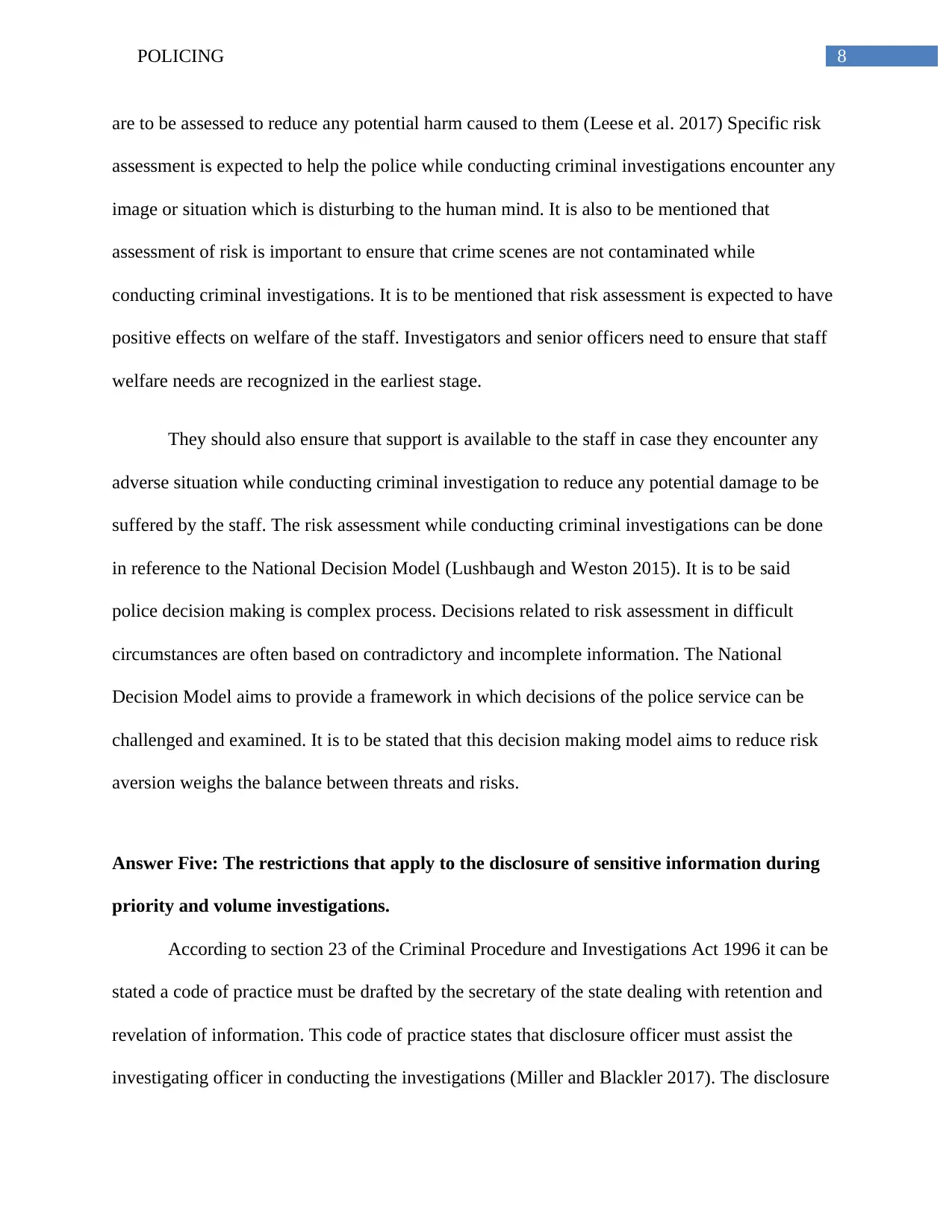
8POLICING
are to be assessed to reduce any potential harm caused to them (Leese et al. 2017) Specific risk
assessment is expected to help the police while conducting criminal investigations encounter any
image or situation which is disturbing to the human mind. It is also to be mentioned that
assessment of risk is important to ensure that crime scenes are not contaminated while
conducting criminal investigations. It is to be mentioned that risk assessment is expected to have
positive effects on welfare of the staff. Investigators and senior officers need to ensure that staff
welfare needs are recognized in the earliest stage.
They should also ensure that support is available to the staff in case they encounter any
adverse situation while conducting criminal investigation to reduce any potential damage to be
suffered by the staff. The risk assessment while conducting criminal investigations can be done
in reference to the National Decision Model (Lushbaugh and Weston 2015). It is to be said
police decision making is complex process. Decisions related to risk assessment in difficult
circumstances are often based on contradictory and incomplete information. The National
Decision Model aims to provide a framework in which decisions of the police service can be
challenged and examined. It is to be stated that this decision making model aims to reduce risk
aversion weighs the balance between threats and risks.
Answer Five: The restrictions that apply to the disclosure of sensitive information during
priority and volume investigations.
According to section 23 of the Criminal Procedure and Investigations Act 1996 it can be
stated a code of practice must be drafted by the secretary of the state dealing with retention and
revelation of information. This code of practice states that disclosure officer must assist the
investigating officer in conducting the investigations (Miller and Blackler 2017). The disclosure
are to be assessed to reduce any potential harm caused to them (Leese et al. 2017) Specific risk
assessment is expected to help the police while conducting criminal investigations encounter any
image or situation which is disturbing to the human mind. It is also to be mentioned that
assessment of risk is important to ensure that crime scenes are not contaminated while
conducting criminal investigations. It is to be mentioned that risk assessment is expected to have
positive effects on welfare of the staff. Investigators and senior officers need to ensure that staff
welfare needs are recognized in the earliest stage.
They should also ensure that support is available to the staff in case they encounter any
adverse situation while conducting criminal investigation to reduce any potential damage to be
suffered by the staff. The risk assessment while conducting criminal investigations can be done
in reference to the National Decision Model (Lushbaugh and Weston 2015). It is to be said
police decision making is complex process. Decisions related to risk assessment in difficult
circumstances are often based on contradictory and incomplete information. The National
Decision Model aims to provide a framework in which decisions of the police service can be
challenged and examined. It is to be stated that this decision making model aims to reduce risk
aversion weighs the balance between threats and risks.
Answer Five: The restrictions that apply to the disclosure of sensitive information during
priority and volume investigations.
According to section 23 of the Criminal Procedure and Investigations Act 1996 it can be
stated a code of practice must be drafted by the secretary of the state dealing with retention and
revelation of information. This code of practice states that disclosure officer must assist the
investigating officer in conducting the investigations (Miller and Blackler 2017). The disclosure
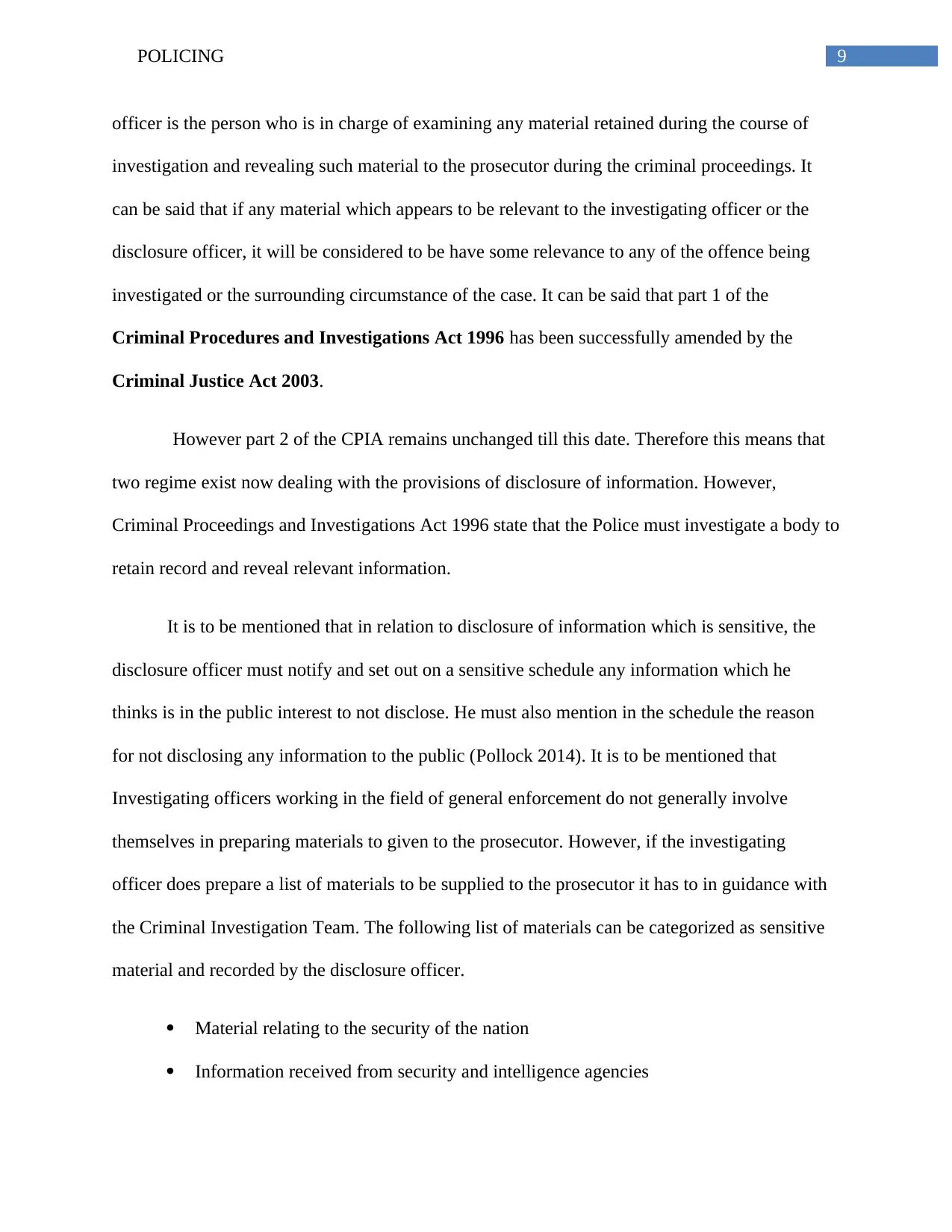
9POLICING
officer is the person who is in charge of examining any material retained during the course of
investigation and revealing such material to the prosecutor during the criminal proceedings. It
can be said that if any material which appears to be relevant to the investigating officer or the
disclosure officer, it will be considered to be have some relevance to any of the offence being
investigated or the surrounding circumstance of the case. It can be said that part 1 of the
Criminal Procedures and Investigations Act 1996 has been successfully amended by the
Criminal Justice Act 2003.
However part 2 of the CPIA remains unchanged till this date. Therefore this means that
two regime exist now dealing with the provisions of disclosure of information. However,
Criminal Proceedings and Investigations Act 1996 state that the Police must investigate a body to
retain record and reveal relevant information.
It is to be mentioned that in relation to disclosure of information which is sensitive, the
disclosure officer must notify and set out on a sensitive schedule any information which he
thinks is in the public interest to not disclose. He must also mention in the schedule the reason
for not disclosing any information to the public (Pollock 2014). It is to be mentioned that
Investigating officers working in the field of general enforcement do not generally involve
themselves in preparing materials to given to the prosecutor. However, if the investigating
officer does prepare a list of materials to be supplied to the prosecutor it has to in guidance with
the Criminal Investigation Team. The following list of materials can be categorized as sensitive
material and recorded by the disclosure officer.
Material relating to the security of the nation
Information received from security and intelligence agencies
officer is the person who is in charge of examining any material retained during the course of
investigation and revealing such material to the prosecutor during the criminal proceedings. It
can be said that if any material which appears to be relevant to the investigating officer or the
disclosure officer, it will be considered to be have some relevance to any of the offence being
investigated or the surrounding circumstance of the case. It can be said that part 1 of the
Criminal Procedures and Investigations Act 1996 has been successfully amended by the
Criminal Justice Act 2003.
However part 2 of the CPIA remains unchanged till this date. Therefore this means that
two regime exist now dealing with the provisions of disclosure of information. However,
Criminal Proceedings and Investigations Act 1996 state that the Police must investigate a body to
retain record and reveal relevant information.
It is to be mentioned that in relation to disclosure of information which is sensitive, the
disclosure officer must notify and set out on a sensitive schedule any information which he
thinks is in the public interest to not disclose. He must also mention in the schedule the reason
for not disclosing any information to the public (Pollock 2014). It is to be mentioned that
Investigating officers working in the field of general enforcement do not generally involve
themselves in preparing materials to given to the prosecutor. However, if the investigating
officer does prepare a list of materials to be supplied to the prosecutor it has to in guidance with
the Criminal Investigation Team. The following list of materials can be categorized as sensitive
material and recorded by the disclosure officer.
Material relating to the security of the nation
Information received from security and intelligence agencies
Secure Best Marks with AI Grader
Need help grading? Try our AI Grader for instant feedback on your assignments.
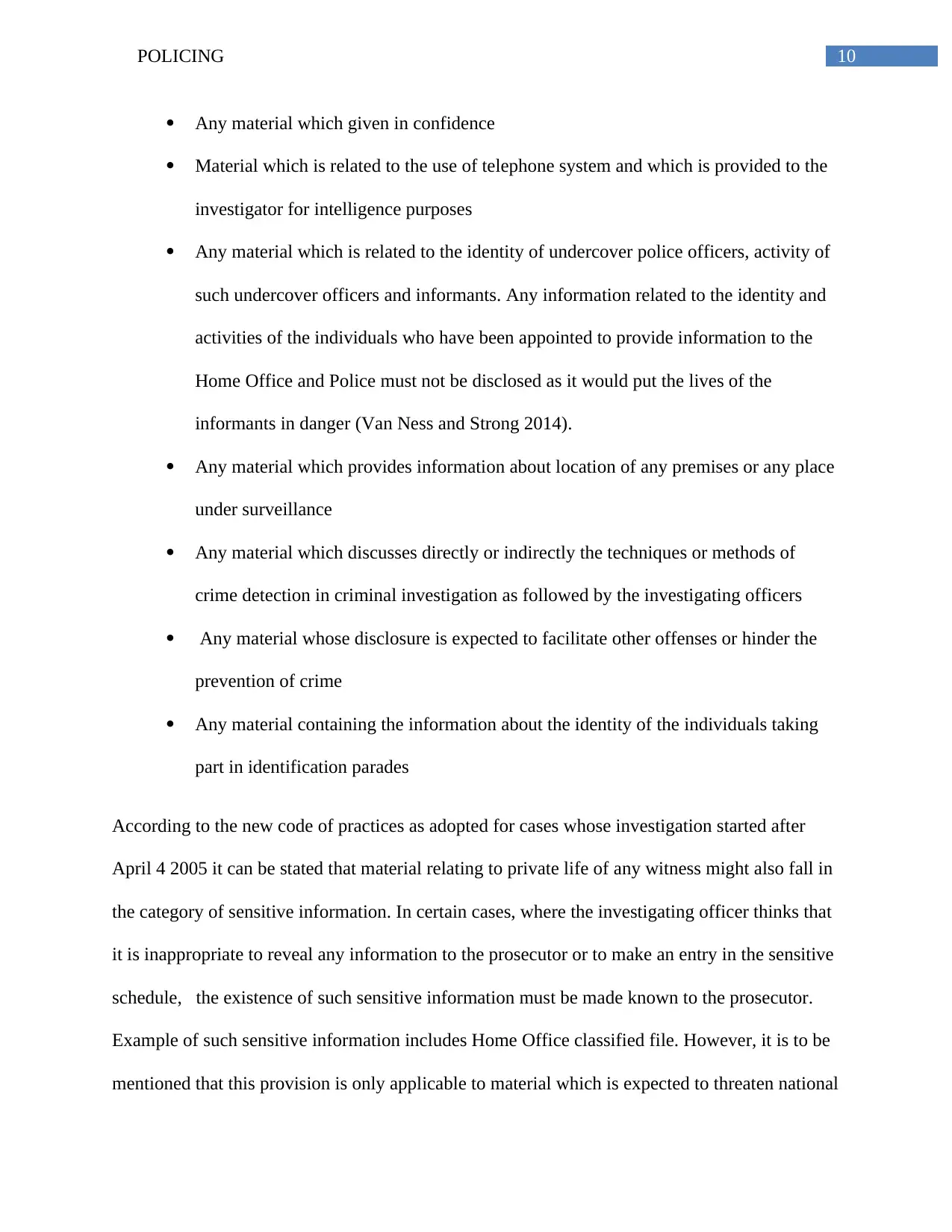
10POLICING
Any material which given in confidence
Material which is related to the use of telephone system and which is provided to the
investigator for intelligence purposes
Any material which is related to the identity of undercover police officers, activity of
such undercover officers and informants. Any information related to the identity and
activities of the individuals who have been appointed to provide information to the
Home Office and Police must not be disclosed as it would put the lives of the
informants in danger (Van Ness and Strong 2014).
Any material which provides information about location of any premises or any place
under surveillance
Any material which discusses directly or indirectly the techniques or methods of
crime detection in criminal investigation as followed by the investigating officers
Any material whose disclosure is expected to facilitate other offenses or hinder the
prevention of crime
Any material containing the information about the identity of the individuals taking
part in identification parades
According to the new code of practices as adopted for cases whose investigation started after
April 4 2005 it can be stated that material relating to private life of any witness might also fall in
the category of sensitive information. In certain cases, where the investigating officer thinks that
it is inappropriate to reveal any information to the prosecutor or to make an entry in the sensitive
schedule, the existence of such sensitive information must be made known to the prosecutor.
Example of such sensitive information includes Home Office classified file. However, it is to be
mentioned that this provision is only applicable to material which is expected to threaten national
Any material which given in confidence
Material which is related to the use of telephone system and which is provided to the
investigator for intelligence purposes
Any material which is related to the identity of undercover police officers, activity of
such undercover officers and informants. Any information related to the identity and
activities of the individuals who have been appointed to provide information to the
Home Office and Police must not be disclosed as it would put the lives of the
informants in danger (Van Ness and Strong 2014).
Any material which provides information about location of any premises or any place
under surveillance
Any material which discusses directly or indirectly the techniques or methods of
crime detection in criminal investigation as followed by the investigating officers
Any material whose disclosure is expected to facilitate other offenses or hinder the
prevention of crime
Any material containing the information about the identity of the individuals taking
part in identification parades
According to the new code of practices as adopted for cases whose investigation started after
April 4 2005 it can be stated that material relating to private life of any witness might also fall in
the category of sensitive information. In certain cases, where the investigating officer thinks that
it is inappropriate to reveal any information to the prosecutor or to make an entry in the sensitive
schedule, the existence of such sensitive information must be made known to the prosecutor.
Example of such sensitive information includes Home Office classified file. However, it is to be
mentioned that this provision is only applicable to material which is expected to threaten national

11POLICING
security and lead to loss of life. Any investigating officer who comes across such sensitive
information while conducting such investigation must inform the Officer in charge of the
investigation and seek his advice prior to taking any action.
security and lead to loss of life. Any investigating officer who comes across such sensitive
information while conducting such investigation must inform the Officer in charge of the
investigation and seek his advice prior to taking any action.
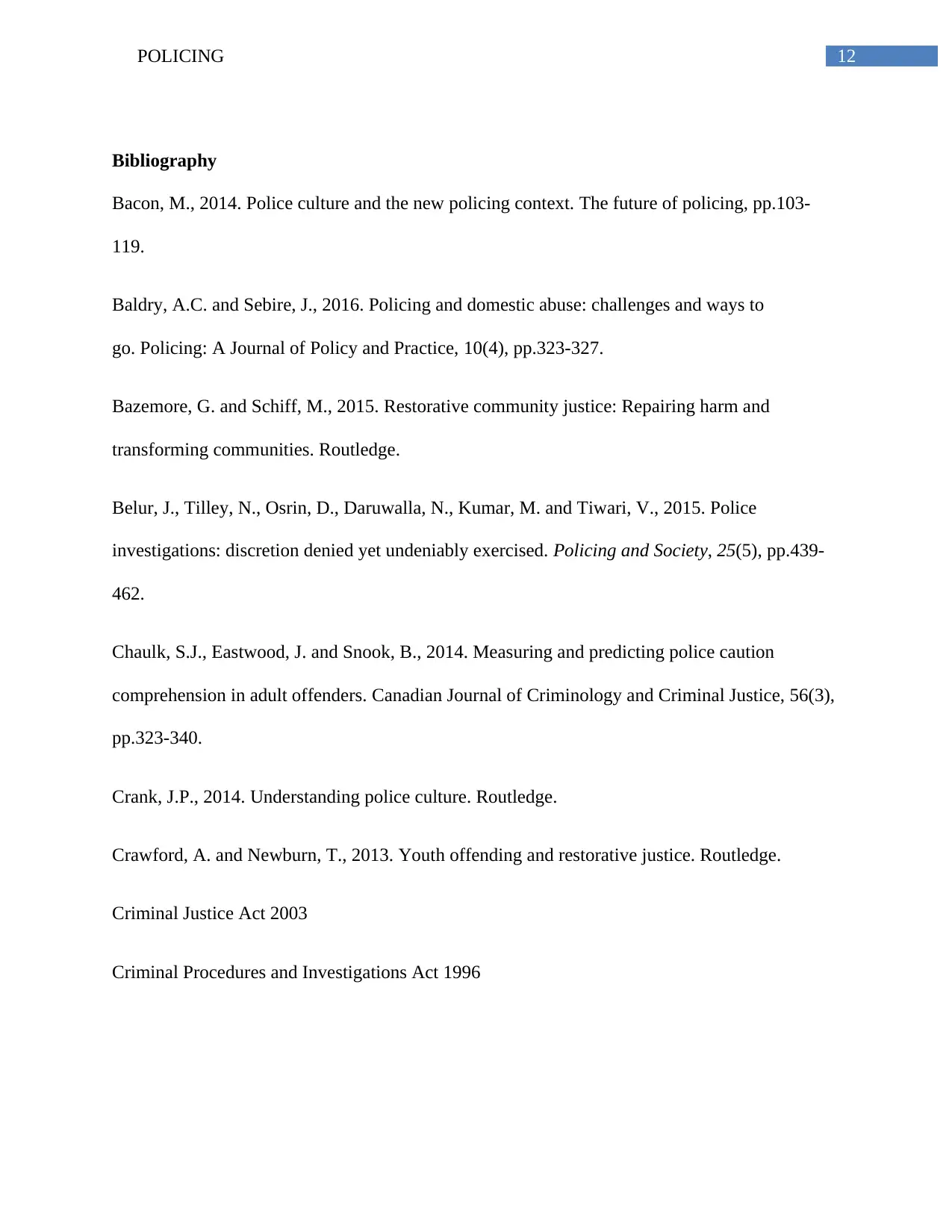
12POLICING
Bibliography
Bacon, M., 2014. Police culture and the new policing context. The future of policing, pp.103-
119.
Baldry, A.C. and Sebire, J., 2016. Policing and domestic abuse: challenges and ways to
go. Policing: A Journal of Policy and Practice, 10(4), pp.323-327.
Bazemore, G. and Schiff, M., 2015. Restorative community justice: Repairing harm and
transforming communities. Routledge.
Belur, J., Tilley, N., Osrin, D., Daruwalla, N., Kumar, M. and Tiwari, V., 2015. Police
investigations: discretion denied yet undeniably exercised. Policing and Society, 25(5), pp.439-
462.
Chaulk, S.J., Eastwood, J. and Snook, B., 2014. Measuring and predicting police caution
comprehension in adult offenders. Canadian Journal of Criminology and Criminal Justice, 56(3),
pp.323-340.
Crank, J.P., 2014. Understanding police culture. Routledge.
Crawford, A. and Newburn, T., 2013. Youth offending and restorative justice. Routledge.
Criminal Justice Act 2003
Criminal Procedures and Investigations Act 1996
Bibliography
Bacon, M., 2014. Police culture and the new policing context. The future of policing, pp.103-
119.
Baldry, A.C. and Sebire, J., 2016. Policing and domestic abuse: challenges and ways to
go. Policing: A Journal of Policy and Practice, 10(4), pp.323-327.
Bazemore, G. and Schiff, M., 2015. Restorative community justice: Repairing harm and
transforming communities. Routledge.
Belur, J., Tilley, N., Osrin, D., Daruwalla, N., Kumar, M. and Tiwari, V., 2015. Police
investigations: discretion denied yet undeniably exercised. Policing and Society, 25(5), pp.439-
462.
Chaulk, S.J., Eastwood, J. and Snook, B., 2014. Measuring and predicting police caution
comprehension in adult offenders. Canadian Journal of Criminology and Criminal Justice, 56(3),
pp.323-340.
Crank, J.P., 2014. Understanding police culture. Routledge.
Crawford, A. and Newburn, T., 2013. Youth offending and restorative justice. Routledge.
Criminal Justice Act 2003
Criminal Procedures and Investigations Act 1996
Paraphrase This Document
Need a fresh take? Get an instant paraphrase of this document with our AI Paraphraser
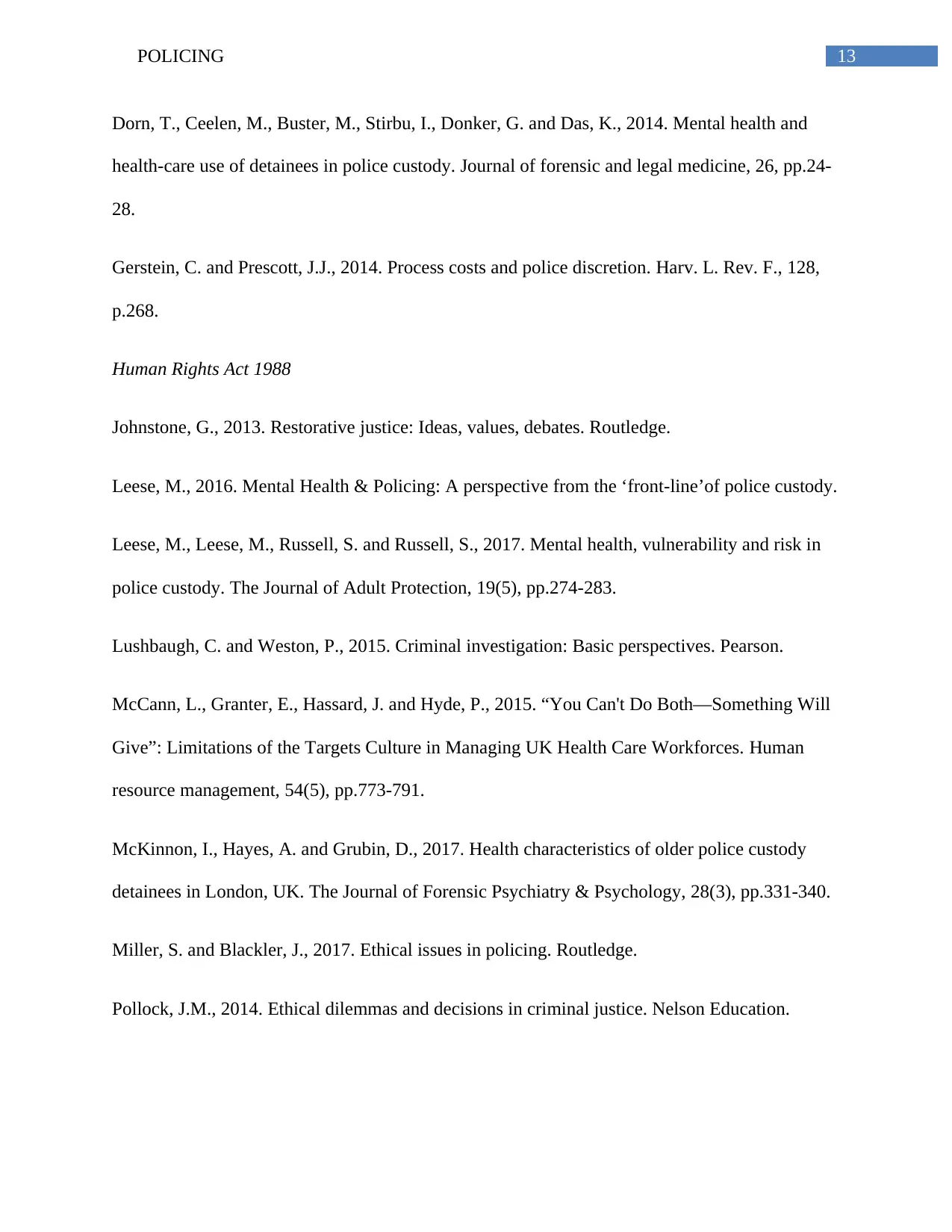
13POLICING
Dorn, T., Ceelen, M., Buster, M., Stirbu, I., Donker, G. and Das, K., 2014. Mental health and
health-care use of detainees in police custody. Journal of forensic and legal medicine, 26, pp.24-
28.
Gerstein, C. and Prescott, J.J., 2014. Process costs and police discretion. Harv. L. Rev. F., 128,
p.268.
Human Rights Act 1988
Johnstone, G., 2013. Restorative justice: Ideas, values, debates. Routledge.
Leese, M., 2016. Mental Health & Policing: A perspective from the ‘front-line’of police custody.
Leese, M., Leese, M., Russell, S. and Russell, S., 2017. Mental health, vulnerability and risk in
police custody. The Journal of Adult Protection, 19(5), pp.274-283.
Lushbaugh, C. and Weston, P., 2015. Criminal investigation: Basic perspectives. Pearson.
McCann, L., Granter, E., Hassard, J. and Hyde, P., 2015. “You Can't Do Both—Something Will
Give”: Limitations of the Targets Culture in Managing UK Health Care Workforces. Human
resource management, 54(5), pp.773-791.
McKinnon, I., Hayes, A. and Grubin, D., 2017. Health characteristics of older police custody
detainees in London, UK. The Journal of Forensic Psychiatry & Psychology, 28(3), pp.331-340.
Miller, S. and Blackler, J., 2017. Ethical issues in policing. Routledge.
Pollock, J.M., 2014. Ethical dilemmas and decisions in criminal justice. Nelson Education.
Dorn, T., Ceelen, M., Buster, M., Stirbu, I., Donker, G. and Das, K., 2014. Mental health and
health-care use of detainees in police custody. Journal of forensic and legal medicine, 26, pp.24-
28.
Gerstein, C. and Prescott, J.J., 2014. Process costs and police discretion. Harv. L. Rev. F., 128,
p.268.
Human Rights Act 1988
Johnstone, G., 2013. Restorative justice: Ideas, values, debates. Routledge.
Leese, M., 2016. Mental Health & Policing: A perspective from the ‘front-line’of police custody.
Leese, M., Leese, M., Russell, S. and Russell, S., 2017. Mental health, vulnerability and risk in
police custody. The Journal of Adult Protection, 19(5), pp.274-283.
Lushbaugh, C. and Weston, P., 2015. Criminal investigation: Basic perspectives. Pearson.
McCann, L., Granter, E., Hassard, J. and Hyde, P., 2015. “You Can't Do Both—Something Will
Give”: Limitations of the Targets Culture in Managing UK Health Care Workforces. Human
resource management, 54(5), pp.773-791.
McKinnon, I., Hayes, A. and Grubin, D., 2017. Health characteristics of older police custody
detainees in London, UK. The Journal of Forensic Psychiatry & Psychology, 28(3), pp.331-340.
Miller, S. and Blackler, J., 2017. Ethical issues in policing. Routledge.
Pollock, J.M., 2014. Ethical dilemmas and decisions in criminal justice. Nelson Education.
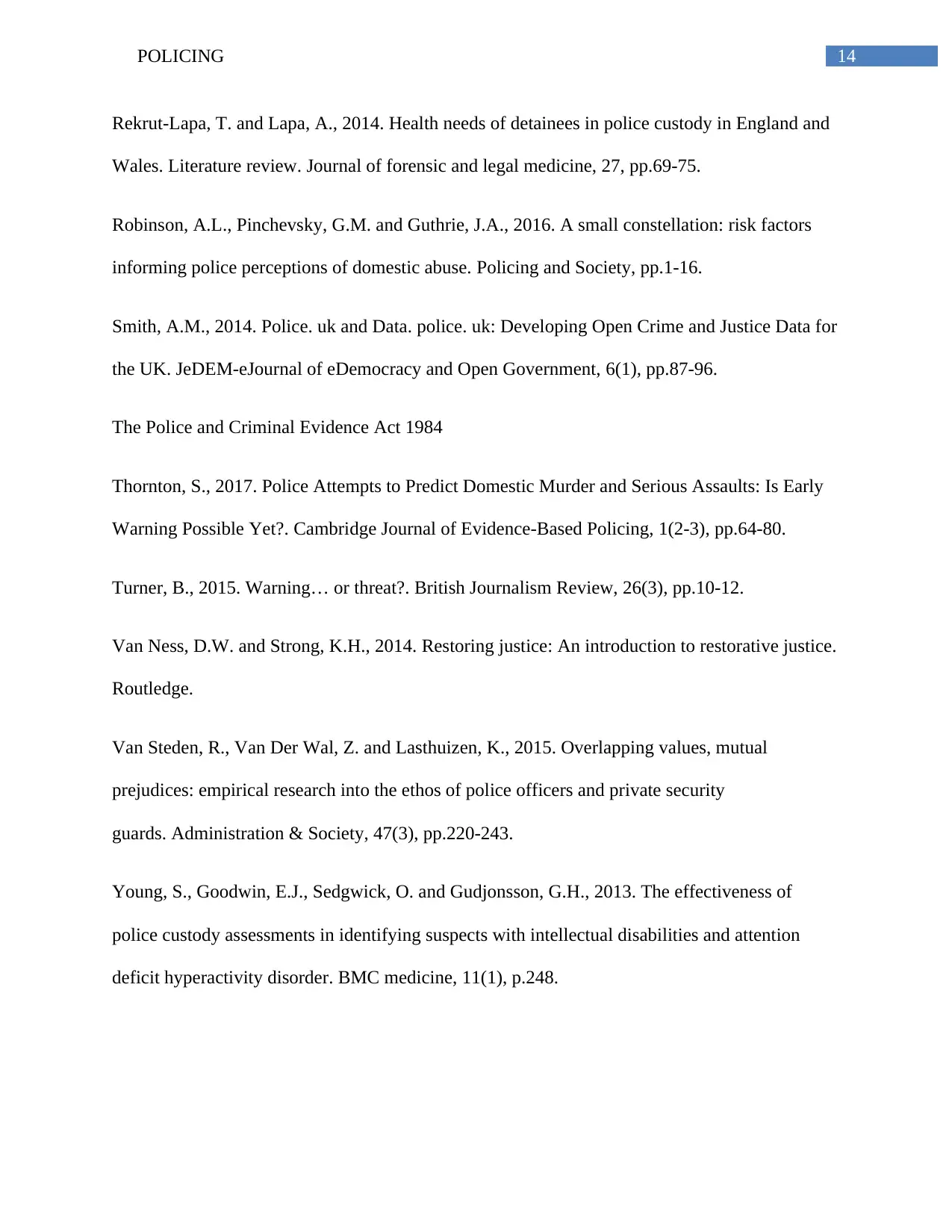
14POLICING
Rekrut-Lapa, T. and Lapa, A., 2014. Health needs of detainees in police custody in England and
Wales. Literature review. Journal of forensic and legal medicine, 27, pp.69-75.
Robinson, A.L., Pinchevsky, G.M. and Guthrie, J.A., 2016. A small constellation: risk factors
informing police perceptions of domestic abuse. Policing and Society, pp.1-16.
Smith, A.M., 2014. Police. uk and Data. police. uk: Developing Open Crime and Justice Data for
the UK. JeDEM-eJournal of eDemocracy and Open Government, 6(1), pp.87-96.
The Police and Criminal Evidence Act 1984
Thornton, S., 2017. Police Attempts to Predict Domestic Murder and Serious Assaults: Is Early
Warning Possible Yet?. Cambridge Journal of Evidence-Based Policing, 1(2-3), pp.64-80.
Turner, B., 2015. Warning… or threat?. British Journalism Review, 26(3), pp.10-12.
Van Ness, D.W. and Strong, K.H., 2014. Restoring justice: An introduction to restorative justice.
Routledge.
Van Steden, R., Van Der Wal, Z. and Lasthuizen, K., 2015. Overlapping values, mutual
prejudices: empirical research into the ethos of police officers and private security
guards. Administration & Society, 47(3), pp.220-243.
Young, S., Goodwin, E.J., Sedgwick, O. and Gudjonsson, G.H., 2013. The effectiveness of
police custody assessments in identifying suspects with intellectual disabilities and attention
deficit hyperactivity disorder. BMC medicine, 11(1), p.248.
Rekrut-Lapa, T. and Lapa, A., 2014. Health needs of detainees in police custody in England and
Wales. Literature review. Journal of forensic and legal medicine, 27, pp.69-75.
Robinson, A.L., Pinchevsky, G.M. and Guthrie, J.A., 2016. A small constellation: risk factors
informing police perceptions of domestic abuse. Policing and Society, pp.1-16.
Smith, A.M., 2014. Police. uk and Data. police. uk: Developing Open Crime and Justice Data for
the UK. JeDEM-eJournal of eDemocracy and Open Government, 6(1), pp.87-96.
The Police and Criminal Evidence Act 1984
Thornton, S., 2017. Police Attempts to Predict Domestic Murder and Serious Assaults: Is Early
Warning Possible Yet?. Cambridge Journal of Evidence-Based Policing, 1(2-3), pp.64-80.
Turner, B., 2015. Warning… or threat?. British Journalism Review, 26(3), pp.10-12.
Van Ness, D.W. and Strong, K.H., 2014. Restoring justice: An introduction to restorative justice.
Routledge.
Van Steden, R., Van Der Wal, Z. and Lasthuizen, K., 2015. Overlapping values, mutual
prejudices: empirical research into the ethos of police officers and private security
guards. Administration & Society, 47(3), pp.220-243.
Young, S., Goodwin, E.J., Sedgwick, O. and Gudjonsson, G.H., 2013. The effectiveness of
police custody assessments in identifying suspects with intellectual disabilities and attention
deficit hyperactivity disorder. BMC medicine, 11(1), p.248.

15POLICING
1 out of 16
Related Documents
Your All-in-One AI-Powered Toolkit for Academic Success.
+13062052269
info@desklib.com
Available 24*7 on WhatsApp / Email
![[object Object]](/_next/static/media/star-bottom.7253800d.svg)
Unlock your academic potential
© 2024 | Zucol Services PVT LTD | All rights reserved.





